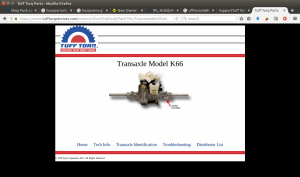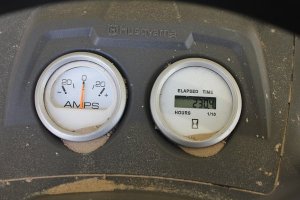Complete K66 Oil Maintenance Guide, By The Step, With Pictures, Start To Finish
Outline
1) Thoughts, Warnings, and Why?
Stage 1-
Getting Your Average Husqvarna GT, or Husqvarna Built for Another Brand GT Ready For Disassembly and Transaxle Access.
1) Preparation For Project
2) Mower Deck Removal by the numbers
Stage 2-
Disassembly as Necessary for Transaxle Maintenance. Easy as 1-2-3…..
1) Prep For Center Console Removal
2) Center Console Removal
Stage 3-
1) Body Removal
2) Fuel Tank Removal
Stage 4-
Tuff Torq K66 Service
Stage 5-
Reassembly, and Test Run
Stage 6-
Easy, By The Numbers Reconnecting The Mower Deck
Stage 7-
All Garden Tractor Accessories Unique To Your Machine and Needs, Such as,
Johnny Bucket JR, Snow Blade, Etc.
(It is my hope in this first part, my general business tone is not confused, it’s just difficult material. I believe it needs to be covered in order to understand, that my purpose, is to help)
When using this guide, please read through the step and tips first before executing. This may help the both of us, you being aware in advance of what to expect, tools you may need, helpers to have on board, parts you may want.
This helps me, I am not a pro at writing, I do my best with trying to write it as easy to understand as possible, and as much as it pains me to admit it- I am human.
The first question I think you may need to answer is why?
These GT's of our can work very hard. Some pictures of my GT's Task's,
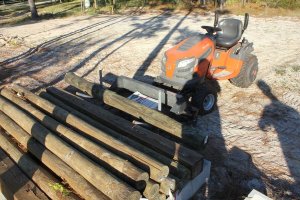
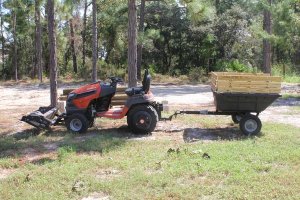
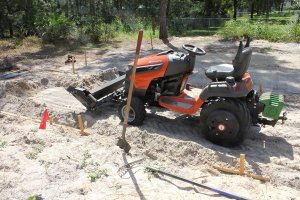
I took a picture 13OCT2019 of the current clock,

That's the fun part!
Also, feel free to show how your GT works for you,
Now lets get some work out of the way,

Husqvarna says the Tuff Torq K66 is “maintenance free”.
Tuff Torq says this, I have supplied the PDF in it's entirety as it comes from Tuff Torq
“FOR CONSUMER USE IN LAWN TRACTOR AND RIDING MOWER APPLICATIONS OIL CHANGING IS NOT EMPHASIZED AS MOST HOMEOWNERS AREN’T EQUIPPED OR IN THE HABIT OF CHANGING TRANSMISSION OIL.”
Translation offered,
Residential use of our transaxle is designed to last the warranty period without maintenance as requested by yard equipment manufacturers, because we believe the average customer won’t do it anyway.
Maintenance free is not a recommendation but rather a short term concession backed by warranty.
When Tuff Torq used the word “consumer” they are referring to their own sales and marketing brochure, ie… Consumer=Residential Grade.
Their residential grade IHT’s (Integrated Hydraulic Transaxle) are TL-200, K46, K57, and K58.
If you look up the machines these are in, they are light duty, mow lawns, light yard work, and are clearly residential grade, they don't offer a means to change the oil, they are 3/4" axles, etc. and are perfectly fine for what they are intended to do. They can be maintained for considerably more effort than ours if someone was asking that question, but this guide is on the K66.
Tuff Torq further states this,
“FOR MOST CUSTOMERS, THE TRANSAXLE WILL OUTLAST THE LIFE OF THE MACHINE. BUT, IT MUST BE SAID THAT CHANGING OIL WILL EXTEND THE LIFE OF THE TRANSMISSION.”
When Tuff Torq says for “most customers” the transaxle will outlast the life of the machine, what are they saying?
We (Tuff Torq and their customers) expect most individual customers will use their riding lawn tractors for mowing grass and occasional yard duty, such as rakes, or small carts.
I’m just looking at this logically, it’s what I see. A few of us are needing heavier use, but not most.
Tuff Torq must meet the demand of their own product and their customers promises. Their customers are mostly yard equipment manufacturers trying to meet the consumer demand for easy, affordable, and readily replaceable.
The second half of this sentence uses the words “must” and “will” to describe the obvious, changing the oil extends the transaxle’s life. Because of the last half of the second quote, I believe Tuff Torq has met their obligation in the first two quotes, speaking for both themselves and their yard equipment manufacturers.
Tuff Torq has 2 more powerful statements, such as this,
“HOWEVER, IN COMMERCIAL AND HEAVY USAGE APPLICATIONS OIL CHANGING IS RECOMMENDED AFTER THE 1 ST 50 HOURS OF OPERATION AND EVERY 200 HOURS, THEREAFTER.”
Once the words “Commercial” and “Heavy Usage” are used is when you see the word “recommended”. Yep, now the game changes, but what does “Commercial” and “Heavy Usage” mean?
I believe the answer is also in Tuff Torq’s sales and marketing brochures and how they classify their transaxles. (I have had this confirmed in email correspondence with Tuff Torq)
The Tuff Torq Professional Series IHT’s are, K62, K66, K72, K92. They are described as for use in Commercial applications and are designed for “Heavy Usage”, ie, “Ground Engagement” and “Serviceable”, they also have heavier 1" plus axles.
If you bought a lawn tractor that has a K62-K92 and only need to mow grass (maybe lots of grass on hills) servicing your transaxle might not have much benefit to your needs, consider where your needs fall between the recommendation or concession, and choose whats best for you.
In this brief review, I want special attention to be brought to the fact that I am not advocating for or against changing the oil. I’ll say it in another way, I am leaving the decision and proper judgment up to the individual that is only qualified to know what is best for their individual circumstances and use. I’m just trying to bring the information to help with some of the why.
The Warning,
I believe most things that are difficult or hard to do are probably worth doing, bringing their own rewards.
After I rebuilt my GT last year from the ground up I performed my first K66 oil change at around 63 hrs. I posted pictures of the process to rebuild the GT and of the transaxle oil at the 63 hrs. The oil was dirty but no metal flakes.
I was asked a question from someone wanting to service their K66, but wanted a guide or some way of simplification to do it, he sounded like a diligent owner to me. I started reasoning a path with him (I had it fresh in my mind) but very quickly realized what a monumental undertaking this was from a position of, he just bought his $3500 TS/GT, and a few words were not going to get the job done.
I performed this K66 oil change again for the second time for the purpose of writing this (JULY-2019), and I still had hope there was an easy way….. I was wrong! (I performed the 50 hr oil change at 63 hrs and the 200 hr oil change at 190 hrs)
I considered there are probably others out there wanting to do the same thing, or at least wanting to have a reliable way of making that determination for themselves because this requires a commitment once you start.
I don’t want to sugar-coat this in any way, after much thought, it’s hard, it may make some feel like you won’t be able to get it back to the same machine you bought or worse, you box it up and take it to hopefully a sympathetic Dealer and ask him to fix it while you eat crow.
Have I scarred you yet?
How about this,
I believe the 5 hardest repairs to make on our GT’s are as follows,
1) Rebuilding or Repairing a Transaxle.
(remember this, to get the transaxle you will be following the steps for servicing one, plus its removal, plus the actual rebuild part. Replacing a Chassis is easier)

2) Rebuilding the Engine.
(doing this right, requires some knowledge, and special tools $$$, but removing the engine requires far fewer steps than number 1!)
3) Replacing the Chassis.
(All the above have to be removed minus any rebuilding in this scenario)
4) Tuff Torq K66 50hr-200hr Oil Change Service.
(This guide will speak for itself why I place it here at number 4)
5) A Complete Overhaul of a Mowing Deck.
Hold up….errr…..The K66 Oil Change is not number 1? but All the way down at number 4?
There’s hope. I wanted to find a way to communicate that it is doable but should not be entered into lightly.
That’s why I spent countless hours at writing each step, following the step to confirm, researching, and of course, 562 pictures (to pull from) to speak to those like myself that learn from sight, each step, and what it should look like from an average start point of mowing deck removal to mowing deck reconnect and turn the key with confidence you missed nothing. I will help you tear down and reassemble by the word, hint, insights, and pictures.
I have now performed this service on my own Tuff Torq K66 twice. A very healthy K66 that is used to move sand, has over 207 hrs now.
I believe anyone can do this with the basic tools I identify and a small dry, safe space, even the space you store your GT. I’m assuming if you have a TS/GT or it’s equivalent, this minimum space and hand tools (you might purchase a few) are already available to you. Even if you own a GT to mow a lawn that is 100’ sq (10’x10') in 3 minutes flat, buy a Harbor Freight 10’x10’ cheapo canopy or it’s equivalent and yep you too! But it might be 20 years before you reach your 50 hr maintenance.
Because of how involved this is in total, I will post each thread by Stage. Next thread will be Stage-1, and I will assume you've read this pre-stage and we will get straight to steps and pictures. I think after Stage-2 or Stage-3, this outline will become self evident.
The next section, Stage-1, Complete K66 Oil-Change Guide GT/TS, Prep, and Mower Removal.
Outline
1) Thoughts, Warnings, and Why?
Stage 1-
Getting Your Average Husqvarna GT, or Husqvarna Built for Another Brand GT Ready For Disassembly and Transaxle Access.
1) Preparation For Project
2) Mower Deck Removal by the numbers
Stage 2-
Disassembly as Necessary for Transaxle Maintenance. Easy as 1-2-3…..
1) Prep For Center Console Removal
2) Center Console Removal
Stage 3-
1) Body Removal
2) Fuel Tank Removal
Stage 4-
Tuff Torq K66 Service
Stage 5-
Reassembly, and Test Run
Stage 6-
Easy, By The Numbers Reconnecting The Mower Deck
Stage 7-
All Garden Tractor Accessories Unique To Your Machine and Needs, Such as,
Johnny Bucket JR, Snow Blade, Etc.
(It is my hope in this first part, my general business tone is not confused, it’s just difficult material. I believe it needs to be covered in order to understand, that my purpose, is to help)
When using this guide, please read through the step and tips first before executing. This may help the both of us, you being aware in advance of what to expect, tools you may need, helpers to have on board, parts you may want.
This helps me, I am not a pro at writing, I do my best with trying to write it as easy to understand as possible, and as much as it pains me to admit it- I am human.
The first question I think you may need to answer is why?
These GT's of our can work very hard. Some pictures of my GT's Task's,



I took a picture 13OCT2019 of the current clock,

That's the fun part!
Also, feel free to show how your GT works for you,
Now lets get some work out of the way,

Husqvarna says the Tuff Torq K66 is “maintenance free”.
Tuff Torq says this, I have supplied the PDF in it's entirety as it comes from Tuff Torq
“FOR CONSUMER USE IN LAWN TRACTOR AND RIDING MOWER APPLICATIONS OIL CHANGING IS NOT EMPHASIZED AS MOST HOMEOWNERS AREN’T EQUIPPED OR IN THE HABIT OF CHANGING TRANSMISSION OIL.”
Translation offered,
Residential use of our transaxle is designed to last the warranty period without maintenance as requested by yard equipment manufacturers, because we believe the average customer won’t do it anyway.
Maintenance free is not a recommendation but rather a short term concession backed by warranty.
When Tuff Torq used the word “consumer” they are referring to their own sales and marketing brochure, ie… Consumer=Residential Grade.
Their residential grade IHT’s (Integrated Hydraulic Transaxle) are TL-200, K46, K57, and K58.
If you look up the machines these are in, they are light duty, mow lawns, light yard work, and are clearly residential grade, they don't offer a means to change the oil, they are 3/4" axles, etc. and are perfectly fine for what they are intended to do. They can be maintained for considerably more effort than ours if someone was asking that question, but this guide is on the K66.
Tuff Torq further states this,
“FOR MOST CUSTOMERS, THE TRANSAXLE WILL OUTLAST THE LIFE OF THE MACHINE. BUT, IT MUST BE SAID THAT CHANGING OIL WILL EXTEND THE LIFE OF THE TRANSMISSION.”
When Tuff Torq says for “most customers” the transaxle will outlast the life of the machine, what are they saying?
We (Tuff Torq and their customers) expect most individual customers will use their riding lawn tractors for mowing grass and occasional yard duty, such as rakes, or small carts.
I’m just looking at this logically, it’s what I see. A few of us are needing heavier use, but not most.
Tuff Torq must meet the demand of their own product and their customers promises. Their customers are mostly yard equipment manufacturers trying to meet the consumer demand for easy, affordable, and readily replaceable.
The second half of this sentence uses the words “must” and “will” to describe the obvious, changing the oil extends the transaxle’s life. Because of the last half of the second quote, I believe Tuff Torq has met their obligation in the first two quotes, speaking for both themselves and their yard equipment manufacturers.
Tuff Torq has 2 more powerful statements, such as this,
“HOWEVER, IN COMMERCIAL AND HEAVY USAGE APPLICATIONS OIL CHANGING IS RECOMMENDED AFTER THE 1 ST 50 HOURS OF OPERATION AND EVERY 200 HOURS, THEREAFTER.”
Once the words “Commercial” and “Heavy Usage” are used is when you see the word “recommended”. Yep, now the game changes, but what does “Commercial” and “Heavy Usage” mean?
I believe the answer is also in Tuff Torq’s sales and marketing brochures and how they classify their transaxles. (I have had this confirmed in email correspondence with Tuff Torq)
The Tuff Torq Professional Series IHT’s are, K62, K66, K72, K92. They are described as for use in Commercial applications and are designed for “Heavy Usage”, ie, “Ground Engagement” and “Serviceable”, they also have heavier 1" plus axles.
If you bought a lawn tractor that has a K62-K92 and only need to mow grass (maybe lots of grass on hills) servicing your transaxle might not have much benefit to your needs, consider where your needs fall between the recommendation or concession, and choose whats best for you.
In this brief review, I want special attention to be brought to the fact that I am not advocating for or against changing the oil. I’ll say it in another way, I am leaving the decision and proper judgment up to the individual that is only qualified to know what is best for their individual circumstances and use. I’m just trying to bring the information to help with some of the why.
The Warning,
I believe most things that are difficult or hard to do are probably worth doing, bringing their own rewards.
After I rebuilt my GT last year from the ground up I performed my first K66 oil change at around 63 hrs. I posted pictures of the process to rebuild the GT and of the transaxle oil at the 63 hrs. The oil was dirty but no metal flakes.
I was asked a question from someone wanting to service their K66, but wanted a guide or some way of simplification to do it, he sounded like a diligent owner to me. I started reasoning a path with him (I had it fresh in my mind) but very quickly realized what a monumental undertaking this was from a position of, he just bought his $3500 TS/GT, and a few words were not going to get the job done.
I performed this K66 oil change again for the second time for the purpose of writing this (JULY-2019), and I still had hope there was an easy way….. I was wrong! (I performed the 50 hr oil change at 63 hrs and the 200 hr oil change at 190 hrs)
I considered there are probably others out there wanting to do the same thing, or at least wanting to have a reliable way of making that determination for themselves because this requires a commitment once you start.
I don’t want to sugar-coat this in any way, after much thought, it’s hard, it may make some feel like you won’t be able to get it back to the same machine you bought or worse, you box it up and take it to hopefully a sympathetic Dealer and ask him to fix it while you eat crow.
Have I scarred you yet?
How about this,
I believe the 5 hardest repairs to make on our GT’s are as follows,
1) Rebuilding or Repairing a Transaxle.
(remember this, to get the transaxle you will be following the steps for servicing one, plus its removal, plus the actual rebuild part. Replacing a Chassis is easier)

2) Rebuilding the Engine.
(doing this right, requires some knowledge, and special tools $$$, but removing the engine requires far fewer steps than number 1!)
3) Replacing the Chassis.
(All the above have to be removed minus any rebuilding in this scenario)
4) Tuff Torq K66 50hr-200hr Oil Change Service.
(This guide will speak for itself why I place it here at number 4)
5) A Complete Overhaul of a Mowing Deck.
Hold up….errr…..The K66 Oil Change is not number 1? but All the way down at number 4?
There’s hope. I wanted to find a way to communicate that it is doable but should not be entered into lightly.
That’s why I spent countless hours at writing each step, following the step to confirm, researching, and of course, 562 pictures (to pull from) to speak to those like myself that learn from sight, each step, and what it should look like from an average start point of mowing deck removal to mowing deck reconnect and turn the key with confidence you missed nothing. I will help you tear down and reassemble by the word, hint, insights, and pictures.
I have now performed this service on my own Tuff Torq K66 twice. A very healthy K66 that is used to move sand, has over 207 hrs now.
I believe anyone can do this with the basic tools I identify and a small dry, safe space, even the space you store your GT. I’m assuming if you have a TS/GT or it’s equivalent, this minimum space and hand tools (you might purchase a few) are already available to you. Even if you own a GT to mow a lawn that is 100’ sq (10’x10') in 3 minutes flat, buy a Harbor Freight 10’x10’ cheapo canopy or it’s equivalent and yep you too! But it might be 20 years before you reach your 50 hr maintenance.
Because of how involved this is in total, I will post each thread by Stage. Next thread will be Stage-1, and I will assume you've read this pre-stage and we will get straight to steps and pictures. I think after Stage-2 or Stage-3, this outline will become self evident.
The next section, Stage-1, Complete K66 Oil-Change Guide GT/TS, Prep, and Mower Removal.

